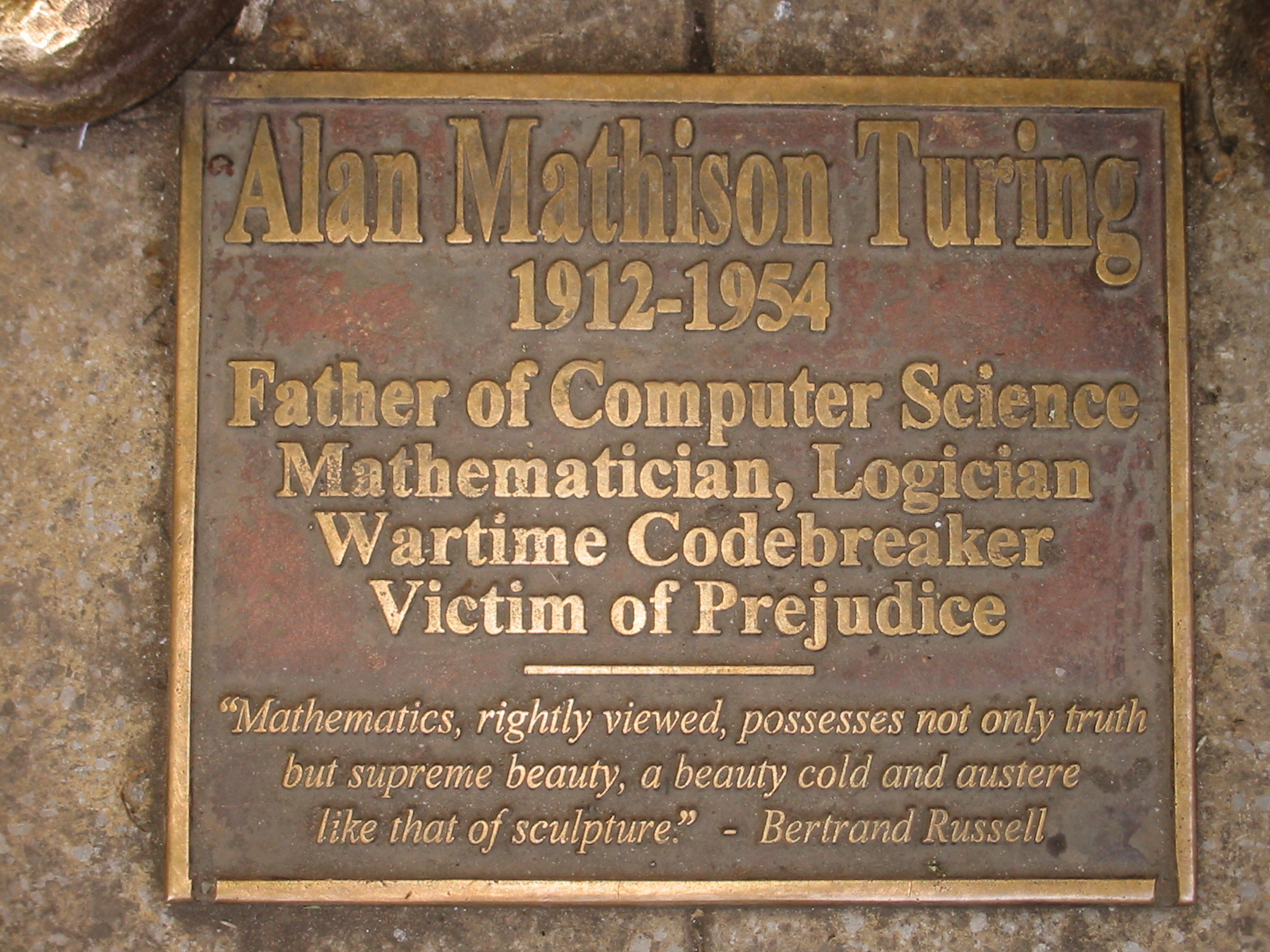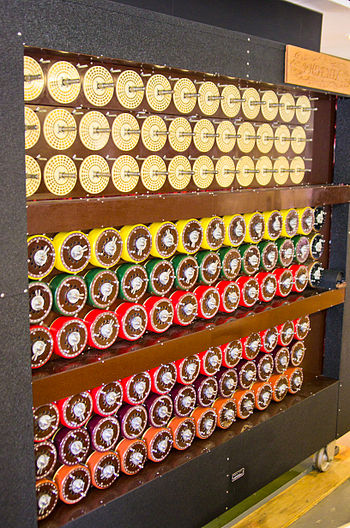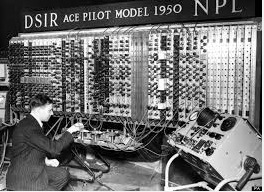|
David first appeared in Wootton in September 2011 when he gave a fascinating and hilarious talk about Ruth Belville, the so-called Greenwich Time Lady, who sold the time to the people of London using an 18th century timepiece, called Arnold, which was set to within a tenth of a second at the Royal Observatory, in Greenwich.
For his much-anticipated second appearance on January 10th, David - now a curator at the Science Museum - gave an equally brilliant exposition of the life of Alan Turing, a genius considered the father of modern computing and artificial intelligence. But set against all his pioneering achievements was a tragic personal life.
Turing is known widely for his code-breaking work at Bletchley Park during the Second World War, having developed the concept of the modern computer in 1936 at the age of just 24. But David told us that he was much more than this – he was also a philosopher, grappling with some of the most fundamental ideas of life and the universe, as well as a chemist and biologist who had started to decode the patterns of life itself.
 However, Turing was also a homosexual when activity between men was still illegal and it would prove to be his downfall, apparently committing suicide. This followed a conviction for gross indecency and being sentenced to a course of female hormone treatment. He died just a few months after it ended, aged 41, from cyanide poisoning.
However, Turing was also a homosexual when activity between men was still illegal and it would prove to be his downfall, apparently committing suicide. This followed a conviction for gross indecency and being sentenced to a course of female hormone treatment. He died just a few months after it ended, aged 41, from cyanide poisoning.
David highlighted Turing’s achievements during his short, but remarkable, life – with his work changing the world and saving millions of lives, breaking both the codes of science and the codes of society. At Bletchley Park, with the help of other talented people, he broke the German naval Enigma system – and almost certainly shortened the war as a result. It was thought impossible to break the cipher system, but Turing (who had joined Bletchley Park, aged only 27 in 1939) and his colleagues managed to do it, cracking codes 24 hours a day, with millions of possible settings tested each time.
David told us that Turning was not afraid to fight for what he wanted, even writing to Prime Minister, Winston Churchill, in 1941 about the shortage of clerical staff – a missive to which Churchill responded quickly, telling his chief of staff to meet their demands “with extreme priority”. Along with a colleague called Gordon Welchman, Turing invented machines called “bombes” that could carry out this industrial scale code-breaking and over 200 of these incredible machines were built at a secret facility nearby.
However, Turing had conceived the idea of universal computing machines in 1936 at Cambridge University when he was just 24. He wrote a paper in which he imagined a single machine that could compute any problem, effectively uniting all these early problem-specific “computers” into one universal device.

Life at Bletchley Park had been quite liberal for the time – but, after the war, David told us that Turing found himself in a far less tolerant place and time. Despite asking a female worker at Bletchley to marry him, Turing knew he was gay and David traced back much of the impetus for his life’s work to falling in love, aged 16, with an older boy, Christopher Morcom, at Sherborne School, in Dorset.
Turing excelled at mathematics but lacked discipline, yet all this changed when he became besotted with Morcom, who was also excellent at maths, and this changed Turing from the ill-focused boy to the genius that he became – with everything he did was an attempt to gain Morcom’s respect. Tragically, Morcom died from TB at the age of 18 and David suggested that Turing’s work in later life was all an effort to keep alive Morcom’s memory in his mind. While he was grieving after Morcom's death in 1930, Turing wrote a short essay expressing his belief that the human spirit can live outside the body. This was a very different side to Turing from the image of the cold, rational mathematician that we are often presented with.
After the war ended, Turing was asked to put his theories and experience into action by developing a ground-breaking computer at the government’s National Physical Laboratory, with his first designs completed by the end of 1945. Turing later accepted a job at Manchester University, but a trial version of his designs (known as Pilot ACE) was completed at the NPL in 1950, with one newspaper reporting that “it could provide the correct answer in one minute to a problem that would occupy a mathematician for a month”. This artefact was at the heart of the award-winning exhibition on Turing which David curated at the Science Museum to commemorate the centenary of his birth.
As he developed electronic computers in the 1940s, Turing also debated whether machines could be made to think like people, and in 1950 he published a seminal paper on the subject. In it, he described what has since become known as the “Turing test”, in which a machine is said to be intelligent if it can successfully imitate the intellectual capabilities of a human in a guessing game.
In addition to all this, Turing developed radical ideas on morphogenesis – the study of pattern formation and growth in nature. David told us the link between mathematics, chemistry and life had long interested Turing, but his access to the powerful new computer at Manchester University gave him the opportunity to explore his ideas in much greater depth.

In early 1950, he had started studying the chemistry of living organisms. The question he set himself was - could a mathematical description of growth and pattern formation be found? Far from being a side-line, this work was a natural continuation of his previous projects. Turing spent the last four years of his life working on a mathematical theory to explain how chemicals in the living organism can break the symmetry of the original cell and cause patterns to emerge. In November 1951, he submitted a paper on his theory to the Royal Society.
Soon afterwards, David added, his personal life became very difficult, as he was first burgled and then, in the aftermath, he was arrested on a charge of “gross indecency” under anti-homosexuality legislation. At this time, doctors were experimenting with ways to “treat” gay people. At his trial for gross indecency, Turing was given a choice of imprisonment or a one-year course of female hormones to remove his sex drive.
David suggested that - perhaps because he was interested in the effects of chemicals on the human body - Turing opted for the latter and his treatment lasted for a year. After it finished, he seemed to be getting back to his work, but his behaviour changed.
Two years after his arrest, on 7 June 1954, Turing was found dead at his Wilmslow home. The pathologist carried out an examination two days later, finding fluid in Turing’s stomach he believed to be cyanide solution – but no suicide note was left.
Alan Turing died aged 41 and David told us it is impossible to know what he might have achieved if he had lived longer. His former colleague, the scientist Max Newman, wrote his obituary: “He began to work out a remarkable chemical theory of the growth of living things…..This work, although it has already excited a good deal of interest, is still in an early, tentative stage so that it is doubtful if it can be carried through to completion by another hand. It remains as a painful reminder of the loss that science has suffered”
“What an absolutely brilliant discourse on one of Britain’s greatest scientists, who not only helped shorten the Second War and save millions of lives, but also developed early computing systems that led to the amazing technology that is now part of everyday life – and which we take so much for granted. Turing must have been a tortured soul but seems to have been likeable and pleasant to his colleagues – and, most certainly, he would have continued producing ground-breaking work. Congratulations to David Rooney on making a complex subject accessible and fascinating. A terrific start to the 2014 Talks – Steve Anderson, London
|